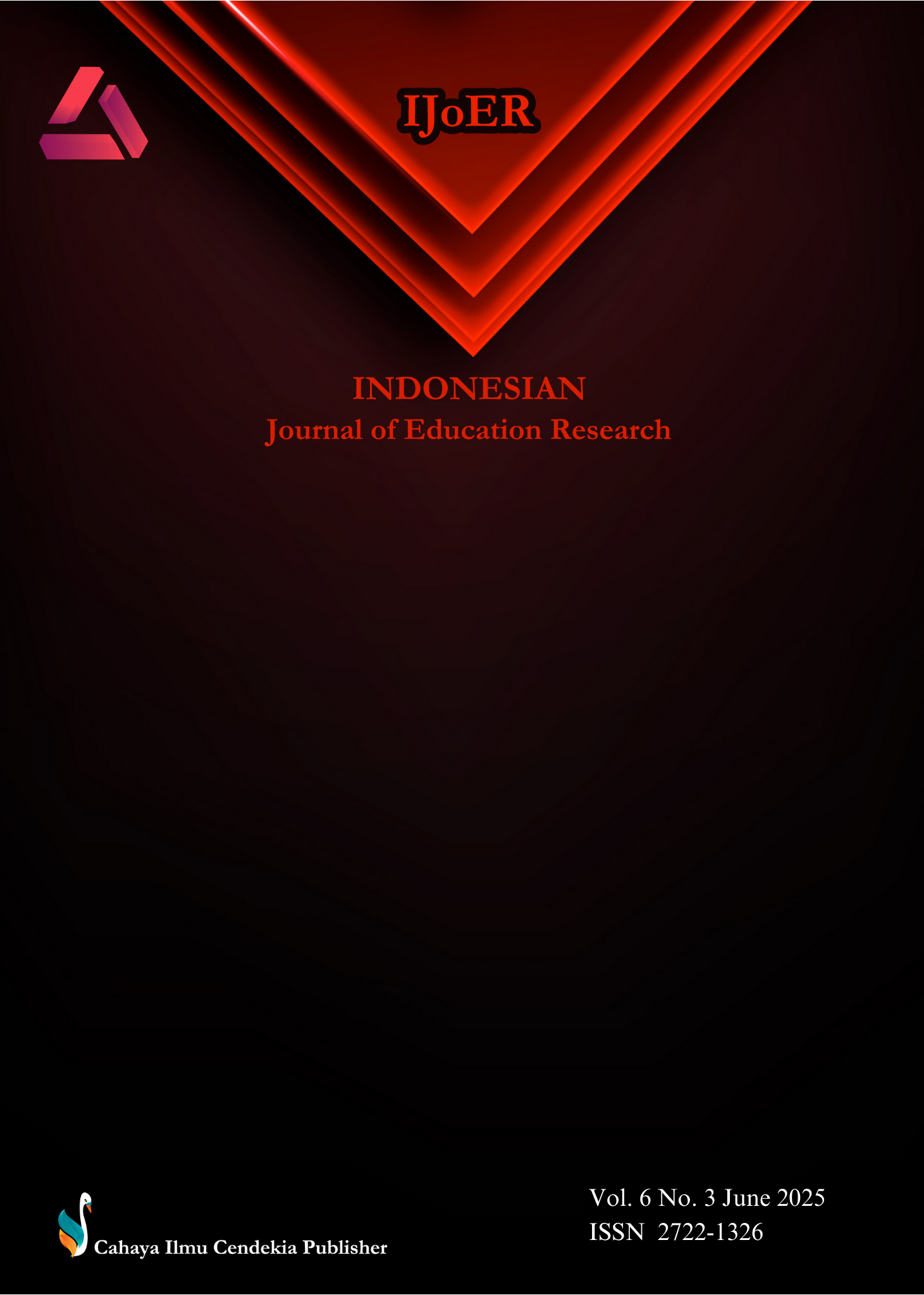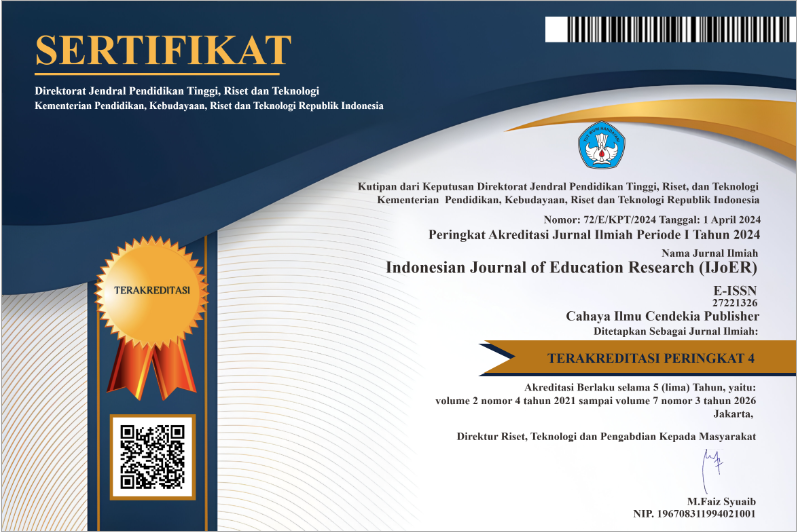Quasi-experimental Study: The Effect of Problem Based Learning Model Assisted by Fyrebox on Students Mathematics Learning Outcomes
Abstract
Purpose of the study: This study aims to determine the effect of the Problem Based Learning (PBL) model assisted by Fyrebox on students' mathematics learning outcomes.
Methodology: This research employed a quantitative approach with a quasi-experimental Posttest-Only Control Group Design. The subjects consisted of 29 students in the experimental group and 30 students in the control group, all from grade XI of Kamal 1 State High School. The research instrument was a post-test in the form of problem-based essay questions. Data were analyzed using the Kolmogorov-Smirnov normality test, Levene's homogeneity test, and the Mann-Whitney U test with the assistance of SPSS 21.
Main Findings: The results showed a significance value of 0.000 < 0.05 in the Mann-Whitney U test, indicating a significant effect of the PBL model assisted by Fyrebox on students' mathematics learning outcomes. The experimental group outperformed the control group in both average score and percentage of completeness.
Novelty/Originality of this study: This study offers originality by integrating the Fyrebox game-based quiz platform into the Problem Based Learning model to enhance student engagement and performance in mathematics. Unlike previous studies that implemented PBL alone or used other digital tools, this research highlights the effectiveness of Fyrebox as a gamified medium that contributes to improved learning outcomes in the digital learning era.
References
R. S. W. Sahmanita and Y. Sutopo, “Penerapan Model Problem Based Learning Berbantuan Wordwall Tipe Matchup Untuk Meningkatkan Hasil Belajar Peserta Didik,” Pendas J. Ilm. Pendidik. Dasar, vol. 09, no. 02, 2024.
A. M. . Siregar, M. br . Sembiring, and D. . Pradesa, “Penerapan Model Problem Based Learning Berbantuan Media Interaktif Wordwall Untuk Meningkatkan Hasil Belajar Peserta Didik ”, ej, vol. 8, no. 2, pp. 458–465, 2024, doi: 10.31537/ej.v8i2.1955
Kemendikbudristek, “Kurikulum Merdeka,” 2024.
A. P. Lubis and I. Nuriadin, “Efektivitas Aplikasi Wordwall untuk Meningkatkan Hasil Belajar Siswa dalam Pembelajaran Matematika Sekolah Dasar,” J. Basicedu, vol. 6, no. 4, pp. 6884–6892, 2022, doi: 10.31004/basicedu.v6i4.3400.
M. P. Putri, L. S. Hariani, and M. Ekowati, “Penerapan model pembelajaran problem based learning ( pbl ) berpadukan dengan word wall game quis untuk meningkatkan motivasi dan hasil belajar pada materi perdagangan internasional kelas xi ips 1,” vol. 1, pp. 783–794, 2024.
I. Ainurrohmah, T. Y. E. Siswono, and W. Wiryanto, “Pengaruh Model Pembelajaran TGT Berbantu Media Wordwall terhadap Kemampuan Berpikir Kritis Siswa,” Ideas J. Pendidikan, Sos. dan Budaya, vol. 10, no. 2, p. 267, 2024, doi: 10.32884/ideas.v10i2.1725.
R. Winda and F. Dafit, “Analisis Kesulitan Guru dalam Penggunaan Media Pembelajaran Online di Sekolah Dasar,” J. Pedagog. dan Pembelajaran, vol. 4, no. 2, p. 211, 2021, doi: 10.23887/jp2.v4i2.38941.
M. A. Akhmad, M. Mustari, M. A. Putra, T. A. Arif, I. Fadollah, and A. Sila, “Penerapan Model Pembelajaran Problem Based Learning Dalam Meningkatkan Hasil Belajar Matematika Siswa Sd,” J. Ilm. Pendidik. Citra Bakti, vol. 10, no. 2, pp. 341–355, 2023, doi: 10.38048/jipcb.v10i2.1462.
M. A. Baalwi, “Pengembangan Media Pembelajaran Teknologi Augmented Reality Berbasis Smartphone Android pada Materi Bangun Ruang,” Journal On Teacher Education, vol. 4, no. 3, pp. 756–761, 2023.
N. Nadila and S. Sitompul, “Pengaruh model pembelajaran problem based learning terhadap peningkatan kemampuan ( the influence of problem based learning learning models,” vol. 04, no. 01, pp. 45–54, 2021.
S. S. Dewi, F. Chasanatun, and L. N. Pradana, “Problem Based Learning ( PBL ) Berbantuan Video Pembelajaran Dapat Meningkatkan Kemampuan Siswa Dalam Menyelesaikan Soal,” Pros. Konf. Ilm. Dasar, vol. 3, pp. 979–984, 2022.
U. Suswati, “Penerapan problem based learning (pbl) meningkatkan hasil belajar kimia umi suswati sman 1 purwanegara,” vol. 1, no. 3, pp. 127–136, 2021.
B. P. F. Hermuttaqien, L. Aras, and S. I. Lastari, “Penerapan Model Pembelajaran Problem Based Learning Untuk Meningkatkan Hasil Belajar Kimia Elektrolisis,” J. Pendidik. dan Profesi Kegur., vol. 2, no. 2, p. 218, 2023, doi: 10.59562/progresif.v2i2.30313.
W. A. Tiyasrini, “Penerapan Model Pembelajaran Berbasis Masalah Problem Based Learning (PBL) Dalam Meningkatkan Hasil Belajar IPS Materi Kegiatan Ekonomi Di Negara Asean Pada Siswa Kelas VI SDN Dawuhansengon II Tahun 2020,” Educ. J. Educ. Res., vol. 3, no. 1, pp. 208–217, 2021, doi: 10.36654/educatif.v3i1.198.
F. E. B. Butar, R. Sidabutar, and G. N. Sauduran, “Jurnal Pendidikan Sains dan Komputer Pengaruh Model Pembelajaran Problem Based Learning ( PBL ) Terhadap Hasil Belajar Matematika,” J. Pendidik. Sains dan Komput., vol. 2, no. 2, pp. 420–426, 2022.
F. Fadilah, Arjindin, T. W. Triutami, and Sripatmi, “Pengaruh Model Pembelajaran Problem Based Learning Terhadap Hasil Belajar Matematika Siswa,” Kogn. J. Ris. HOTS Pendidik. Mat., vol. 3, no. 2, pp. 148–157, 2023, doi: 10.51574/kognitif.v3i2.955.
A. Syarifah, E. N. Sa’adah, E. Qotrunnada, and A. A. A. Aziz, “Penerapan Aplikasi Fyrebox sebagai Instrumen Penilaian Evaluasi Siswa Sekolah Dasar,” Edukatif J. Ilmu Pendidik., vol. 6, no. 1, pp. 353–362, 2024, doi: 10.31004/edukatif.v6i1.5327.
N. Q. Ahmad and R. Babo, “Pengaruh Model Pembelajaran Problem Based Learning ( PBL ) Berbantuan Aplikasi Quizizz terhadap Minat dan Hasil Belajar Siswa Pada Mata Pelajaran IPS Kelas IV SD Inpres Bontomanai,” vol. 07, no. 01, pp. 3175–3192, 2024.
M. P. Ariyanto, Z. R. Nurcahyandi, and S. A. Diva, “Penggunaan Gamifikasi Wordwall untuk Meningkatkan Hasil Belajar Matematika Siswa,” vol. 5, no. 1, pp. 1–10, 2023.
S. M. U. Hasibuan, F. . Rakhmawati, dan R. U. . Hasanah, “Pengaruh model problem based learning terhadap hasil belajar dan motivasi belajar matematika siswa ”, Relevan, vol. 4, no. 5, 2024.
R. N. Riny, H. S. Astutik, and S. F. Rabia, “Pengaruh model problem based learning (pbl) terhadap hasil belajar matematika siswa sd”, theorema, vol. 5, no. 2, Dec. 2024.
Sugiyono, “Metode Penelitian Kuantitatif, kualitatif, dan R&D,” 2018, Alfabeta.
T. Samuel, R. Azen, and N. Campbell-Kyureghyan, “Evaluation of Learning Outcomes Through Multiple Choice Pre- and Post-Training Assessments,” J. Educ. Learn., vol. 8, no. 3, p. 122, 2019, doi: 10.5539/jel.v8n3p122.
S. Sainuddin, B. Subali, Jailani, and M. Elvira, “The Development and Validation Prospective Mathematics Teachers Holistic Assessment Tools,” Ing. des Syst. d’Information, vol. 27, no. 2, pp. 171–184, 2022, doi: 10.18280/isi.270201.
P. T. Shivaraju, G. Manu, M. Vinaya, and M. K. Savkar, “Evaluating the effectiveness of pre- and post-test model of learning in a medical school,” Natl. J. Physiol. Pharm. Pharmacol., vol. 7, no. 9, pp. 947–951, 2017, doi: 10.5455/njppp.2017.7.0412802052017.
A. Quraisy, “Normalitas Data Menggunakan Uji Kolmogorov-Smirnov dan Saphiro-Wilk,” J-HEST J. Heal. Educ. Econ. Sci. Technol., vol. 3, no. 1, pp. 7–11, 2022, doi: 10.36339/jhest.v3i1.42.
X. Li et al., “A Comparative Study of Tests for Homogeneity of Variances with Application to DNA Methylation Data,” PLoS One, vol. 10, no. 12, pp. 1–12, 2015, doi: 10.1371/journal.pone.0145295.
R. Normelia, T. D. Fortuna, E. P. Putri, and E. Widodo, “Analisis Mann-Whitney untuk Mengetahui Efektivitas Vaksin pada Jumlah Penderita Covid-19 di Indonesia,” J. Sains Mat. dan Stat., vol. 8, no. 1, p. 27, 2022, doi: 10.24014/jsms.v8i1.15087.
R. P. Sonjaya, F. R. Aliyya, and S. Naufal, “Pengujian Prasyarat Analisis Data Nilai Kelas : Uji Normalitas dan Uji Homogenitas,” vol. 9, pp. 1627–1639, 2025.
I. Sintia, M. D. Pasarella, and D. A. Nohe, “Perbandingan Tingkat Konsistensi Uji Distribusi Normalitas Pada Kasus Tingkat Pengangguran di Jawa,” Pros. Semin. Nas. Mat. Stat. dan Apl., vol. 2, no. 2, pp. 322–333, 2022.
Z. Mufarrikoh, “Analisis Mann-Whitney pada Pemahaman Materi Statistika Pendidikan,” Students’ Difficulties Elem. Sch. Increasing Lit. Abil., vol. 4, no. 1, pp. 1–12, 2022.
A. Damanhuri and A. Solikin, “Implementasi uji mann-whitney dalam evaluasi prestasi hasil belajar kegiatan pelatihan sails fakultas syariah dan hukum uinsa,” vol. 7, no. 1, pp. 17–23, 2022.
E. Listyaningsih, N. Nugraheni, and I. B. Yuliasih, “Peningkatan Hasil Belajar Melalui Pendekatan TarlModel PBL Dalam Matematika Kelas V SDN Bendan Ngisor,” Madani J. Ilm. Multidisipline, vol. 1, no. 6, pp. 620–627, 2023, doi: 10.5281/zenodo.8139269
L. Yuna and W. Oviana, “Problem based Learning: A Learning Model to Improve Student Learning Outcomes,” Indones. J. Educ. Soc. Humanit., vol. 1, no. March, pp. 19–27, 2024.
M. Husanah and Y. Fitria, “Pengaruh Model Problem Based Learning Terhadap Kemampuan Kognitif IPA pada Pembelajaran Tematik Terpadu,” J. Basicedu, vol. 5, no. 5, pp. 3(2), 524–532, 2020.
Copyright (c) 2025 Farah Aprilia Rosyadi, Rica Wijayanti

This work is licensed under a Creative Commons Attribution 4.0 International License.
Authors who publish with this journal agree to the following terms:
- Authors retain copyright and acknowledge that the Indonesian Journal of Education Research (IJoER) is the first publisher licensed under a Creative Commons Attribution 4.0 International License.
- Authors are able to enter into separate, additional contractual arrangements for the non-exclusive distribution of the journal's published version of the work (e.g., post it to an institutional repository or publish it in a book), with an acknowledgment of its initial publication in this journal.
- Authors are permitted and encouraged to post their work online (e.g., in institutional repositories or on their website) prior to and during the submission process, as it can lead to productive exchanges and earlier and greater citation of published work.







.png)
.png)




















